This experiment is too, too, too difficult! I can't write it myself. After reading two articles by two big men, I found out. Directly paste the two articles of the boss. One is implemented with an implicit linked list, and the other is implemented with a display linked list.
Implicit free linked list
The job is compiled into a 32-bit program. I use the WSL sub operating system of Windows, which does not support 32-bit programs. Please refer to here To modify.
I've been doing this for two days, and I've encountered some errors. It's very difficult to debug, but I've made some results. I don't want full marks, so I'll strengthen my understanding of the dynamic allocator.
The experiment is mainly to let us implement a dynamic distributor to realize mm_init,mm_malloc,mm_free and mm_realloc function. Two simple validation files, short1 - BAL, are then provided Rep and short2 BAL Rep to test the memory utilization and throughput of our algorithm. We can call/ mdriver -f short1-bal.rep -V to view the test results of a single file. Then someone on github uploaded other test data of the course, which can be downloaded from here Download, get a trace folder, and then call. mdriver -t ./trace -V to view the test results.
First, we use the data structure of blocks with feet, as shown below. And set the pointer bp to the block to point to the payload, so that the payload in the block can be accessed directly through bp.
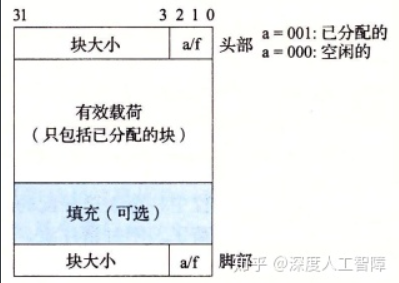
Based on this, we can determine some macros
//Word size and doubleword size #define WSIZE 4 #define DSIZE 8 //The heap space requested from the kernel when the heap memory is insufficient #define CHUNKSIZE (1<<12) //Put val into the 4 bytes beginning with p #define PUT(p,val) (*(unsigned int*)(p) = (val)) //Get head and foot coding #define PACK(size, alloc) ((size) | (alloc)) //Obtain block size and allocated bits from the head or feet #define GET_SIZE(p) (*(unsigned int*)(p) & ~0x7) #define GET_ALLO(p) (*(unsigned int*)(p) & 0x1) //Get the head and feet of the block #define HDRP(bp) ((char*)(bp) - WSIZE) #define FTRP(bp) ((char*)(bp) + GET_SIZE(HDRP(bp)) - DSIZE) //Gets the previous block and the next block #define NEXT_BLKP(bp) ((char*)(bp) + GET_SIZE(HDRP(bp))) #define PREV_BLKP(bp) ((char*)(bp) - GET_SIZE((char*)(bp) - DSIZE)) #define MAX(x,y) ((x)>(y)?(x):(y))
**Note: * * the bp pointer we passed in may be of void * type. If bp is calculated, its forced type should be converted to char *, so the value of addition and subtraction is the number of bytes.
//Payload pointing to the preamble block of the implicit free linked list
static char *heap_listp;
/*
* mm_init - initialize the malloc package.
*/
int mm_init(void){
if((heap_listp = mem_sbrk(4*WSIZE)) == (void*)-1) //Apply for 4-word space
return -1;
PUT(heap_listp, 0); //Filler block
PUT(heap_listp+1*WSIZE, PACK(DSIZE, 1)); //Preamble block head
PUT(heap_listp+2*WSIZE, PACK(DSIZE, 1)); //Foreword block foot
PUT(heap_listp+3*WSIZE, PACK(0, 1)); //End block
heap_listp += DSIZE; //Pointer to preamble payload
if(expend_heap(CHUNKSIZE/WSIZE) == NULL) //Request more heap space
return -1;
return 0;
}
This part is used to create the initial implicit free list. Our implicit free list has the following structure

First, you need an allocated preamble block containing the head and feet, which will never be released, with a size of 8 bytes, as the beginning of the implicit free linked list. Then there are some ordinary blocks, including allocated blocks and free blocks. Finally, there is an allocated end block with block size of 0, which only contains the header and size of 4 bytes. As the end of the implicit free linked list, we will see why the end block is set like this later.
Now, there are three words in the ordinary block 1 plus the preamble block and its own header. In order to ensure that the payload of the block is double word aligned, a block of one word is filled at the beginning of the heap.
Then we make a pointer heap_listp points to the payload part of the preamble block as the starting pointer of the implicit free linked list. Then, there is no part of the implicit free linked list that can hold other data, so expand is called_ Heap to apply for more heap space. Here, a fixed size space is applied at one time, which is defined by CHUNKSIZE.
static void *expend_heap(size_t words){
size_t size;
void *bp;
size = words%2 ? (words+1)*WSIZE : words*WSIZE; //Align size doubleword
if((bp = mem_sbrk(size)) == (void*)-1) //Application space
return NULL;
PUT(HDRP(bp), PACK(size, 0)); //Set header
PUT(FTRP(bp), PACK(size, 0)); //Set feet
PUT(HDRP(NEXT_BLKP(bp)), PACK(0, 1)); //Set new end block
//Merge now
return imme_coalesce(bp);
//return bp;
}
This function passes in the number of words. First, ensure that the number of words is doubleword aligned, and then apply for the corresponding heap space. Next, take the requested heap space as a free block and set the head and feet. Note that the relationship between the bp pointer and the implicit free linked list is as follows

At this point, we call PUT(HDRP(bp),PACK(size,0)); To set the header of the new free block, it can be found that the previous end block is taken as the header of the current free block, while PUT(HDRP(NEXT_BLKP(bp)),PACK(0,1)); Is to take the last word as the ending block. This makes full use of the original ending block space.
At this time, the free block may also be preceded by a free block, so you can call imme_coalesce(bp) for immediate consolidation.
static void *imme_coalesce(void *bp){
size_t prev_alloc = GET_ALLO(FTRP(PREV_BLKP(bp))); //Gets the allocated bit of the previous block
size_t next_alloc = GET_ALLO(HDRP(NEXT_BLKP(bp))); //Gets the allocated bit of the following block
size_t size = GET_SIZE(HDRP(bp)); //Gets the size of the current block
if(prev_alloc && next_alloc){
return bp;
}else if(prev_alloc && !next_alloc){
size += GET_SIZE(HDRP(NEXT_BLKP(bp)));
PUT(HDRP(bp), PACK(size, 0));
PUT(FTRP(bp), PACK(size, 0));
}else if(!prev_alloc && next_alloc){
size += GET_SIZE(FTRP(PREV_BLKP(bp)));
PUT(HDRP(PREV_BLKP(bp)), PACK(size, 0));
PUT(FTRP(bp), PACK(size, 0));
bp = PREV_BLKP(bp);
}else{
size += GET_SIZE(HDRP(NEXT_BLKP(bp))) +
GET_SIZE(FTRP(PREV_BLKP(bp)));
PUT(HDRP(PREV_BLKP(bp)), PACK(size, 0));
PUT(FTRP(NEXT_BLKP(bp)), PACK(size, 0));
bp = PREV_BLKP(bp);
}
return bp;
}
This function determines how to merge according to the allocated bits of the previous block and the next block of bp, as shown below
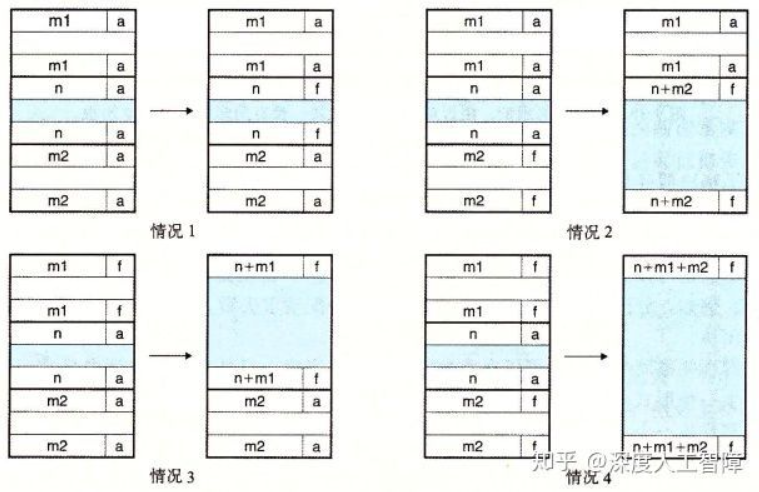
In fact, we only need to modify the block size fields in the head and feet of the corresponding block, and then modify bp as needed to point to the merged free block.
Then we can see our mm_malloc function
void *mm_malloc(size_t size){
size_t asize;
void *bp;
if(size == 0)
return NULL;
//Meet the minimum block requirements and alignment requirements, and size is the payload size
asize = size<=DSIZE ? 2*DSIZE : DSIZE * ((size + (DSIZE) + (DSIZE-1)) / DSIZE);
//First match
if((bp = first_fit(asize)) != NULL){
place(bp, asize);
return bp;
}
//Best match
/*if((bp = best_fit(asize)) != NULL){
place(bp, asize);
return bp;
}*/
//Postpone merger
//delay_coalesce();
//Best match
/*if((bp = best_fit(asize)) != NULL){
place(bp, asize);
return bp;
}*/
//First match
/*if((bp = first_fit(asize)) != NULL){
place(bp, asize);
return bp;
}*/
if((bp = expend_heap(MAX(CHUNKSIZE, asize)/WSIZE)) == NULL)
return NULL;
place(bp, asize);
return bp;
}
First, mm_ The size parameter size passed by malloc refers to the payload of the block. When we search for the free block, the size of the free block includes the head, payload and feet. Therefore, we need to add the size of these two parts and align them in double words to get the size asize for comparison. Then we can use asize to search for suitable free blocks. There are two strategies: first adaptation and best adaptation. Moreover, if we use delayed merging of free blocks, if we can't find a suitable free block, we need to delay merging and find it again. If we still can't find it, it means that there is not enough heap space. At this time, we need to apply for heap space again, and then put the space we want into the free block.
First look at the first adaptation
static void *first_fit(size_t asize){
void *bp = heap_listp;
size_t size;
while((size = GET_SIZE(HDRP(bp))) != 0){ //Traverse all blocks
if(size >= asize && !GET_ALLO(HDRP(bp))) //Look for free blocks larger than asize
return bp;
bp = NEXT_BLKP(bp);
}
return NULL;
}
Take the end block of the implicit free linked list as the end, and judge the blocks in the linked list in turn. If there is a free block larger than asize, it will be returned directly.
We can also see the best fit
static void *best_fit(size_t asize){
void *bp = heap_listp;
size_t size;
void *best = NULL;
size_t min_size = 0;
while((size = GET_SIZE(HDRP(bp))) != 0){
if(size >= asize && !GET_ALLO(HDRP(bp)) && (min_size == 0 || min_size>size)){ //Record the smallest suitable free block
min_size = size;
best = bp;
}
bp = NEXT_BLKP(bp);
}
return best;
}
It will search for the smallest suitable free block, which can reduce the generation of fragments and improve memory utilization.
When we find a suitable free block, we need to put the space we need into the free block
static void place(void *bp, size_t asize){
size_t remain_size;
remain_size = GET_SIZE(HDRP(bp)) - asize; //Calculate the remaining space after asize is removed from the free block
if(remain_size >= DSIZE){ //If the remaining space meets the minimum block size, it is regarded as a new free block
PUT(HDRP(bp), PACK(asize, 1));
PUT(FTRP(bp), PACK(asize, 1));
PUT(HDRP(NEXT_BLKP(bp)), PACK(remain_size, 0));
PUT(FTRP(NEXT_BLKP(bp)), PACK(remain_size, 0));
}else{
PUT(HDRP(bp), PACK(GET_SIZE(HDRP(bp)), 1));
PUT(FTRP(bp), PACK(GET_SIZE(HDRP(bp)), 1));
}
}
First, we need to calculate the remaining space of the free block after asize is removed. If the remaining space can fill the head and feet to form a new free block, the free block will be divided. Otherwise, the whole free block will be used to set the allocated bit of the block.
Then you can look at the code for deferred merging
static void *delay_coalesce(){
void *bp = heap_listp;
while(GET_SIZE(HDRP(bp)) != 0){
if(!GET_ALLO(HDRP(bp)))
bp = imme_coalesce(bp);
bp = NEXT_BLKP(bp);
}
}
Traverse all blocks of the free linked list. If it is a free block, merge it with the surrounding blocks.
Next, let's take a look at our mm_free
/*
* mm_free - Freeing a block does nothing.
*/
void mm_free(void *ptr){
size_t size = GET_SIZE(HDRP(ptr));
PUT(HDRP(ptr), PACK(size, 0));
PUT(FTRP(ptr), PACK(size, 0));
//Merge now
imme_coalesce(ptr);
}
We first set the allocated bit of the block to the idle state, and then merge it immediately.
Finally, it's our mm_realloc
/*
* mm_realloc - Implemented simply in terms of mm_malloc and mm_free
*/
void *mm_realloc(void *ptr, size_t size){
size_t asize, ptr_size;
void *new_bp;
if(ptr == NULL)
return mm_malloc(size);
if(size == 0){
mm_free(ptr);
return NULL;
}
asize = size<=DSIZE ? 2*DSIZE : DSIZE * ((size + (DSIZE) + (DSIZE-1)) / DSIZE);
new_bp = imme_coalesce(ptr); //Try if you have free
ptr_size = GET_SIZE(HDRP(new_bp));
PUT(HDRP(new_bp), PACK(ptr_size, 1));
PUT(FTRP(new_bp), PACK(ptr_size, 1));
if(new_bp != ptr) //If the previous free blocks are merged, the original content is moved forward
memcpy(new_bp, ptr, GET_SIZE(HDRP(ptr)) - DSIZE);
if(ptr_size == asize)
return new_bp;
else if(ptr_size > asize){
place(new_bp, asize);
return new_bp;
}else{
ptr = mm_malloc(asize);
if(ptr == NULL)
return NULL;
memcpy(ptr, new_bp, ptr_size - DSIZE);
mm_free(new_bp);
return ptr;
}
}
First, if ptr is NULL, the space of size is allocated directly. If size is 0, the space pointed to by ptr is released directly. Otherwise, mm is required_ realloc. When we execute mm_ In realloc, ptr refers to the allocated block, and there may be free blocks around it. After adding free blocks, it may meet the size requirements of asize, so we can try to merge ptr with the surrounding free blocks first.
Then here are the experimental results
First fit + immediate merge:
Results for mm malloc: trace valid util ops secs Kops 0 yes 99% 5694 0.014197 401 1 yes 99% 5848 0.013547 432 2 yes 99% 6648 0.021787 305 3 yes 100% 5380 0.016372 329 4 yes 66% 14400 0.001061 13570 5 yes 92% 4800 0.014609 329 6 yes 92% 4800 0.013454 357 7 yes 55% 12000 0.203199 59 8 yes 51% 24000 0.572411 42 9 yes 44% 14401 0.152757 94 10 yes 45% 14401 0.029385 490 Total 77% 112372 1.052780 107 Perf index = 46 (util) + 7 (thru) = 53/100
First match + delayed merge:
Results for mm malloc: trace valid util ops secs Kops 0 yes 99% 5694 0.033440 170 1 yes 99% 5848 0.028946 202 2 yes 99% 6648 0.062765 106 3 yes 99% 5380 0.056375 95 4 yes 66% 14400 0.001050 13721 5 yes 92% 4800 0.029646 162 6 yes 90% 4800 0.027486 175 7 yes 60% 12000 0.214382 56 8 yes 53% 24000 0.584505 41 9 yes 35% 14401 0.813350 18 10 yes 45% 14401 0.019537 737 Total 76% 112372 1.871480 60 Perf index = 46 (util) + 4 (thru) = 50/100
Best bet + merge now:
Results for mm malloc: trace valid util ops secs Kops 0 yes 99% 5694 0.015399 370 1 yes 99% 5848 0.014503 403 2 yes 99% 6648 0.023172 287 3 yes 100% 5380 0.017809 302 4 yes 66% 14400 0.001038 13878 5 yes 96% 4800 0.030279 159 6 yes 95% 4800 0.028814 167 7 yes 55% 12000 0.201558 60 8 yes 51% 24000 0.601187 40 9 yes 40% 14401 0.003348 4302 10 yes 45% 14401 0.002100 6856 Total 77% 112372 0.939206 120 Perf index = 46 (util) + 8 (thru) = 54/100
Best fit + delayed merge:
Results for mm malloc: trace valid util ops secs Kops 0 yes 99% 5694 0.038064 150 1 yes 99% 5848 0.036293 161 2 yes 99% 6648 0.073700 90 3 yes 99% 5380 0.072891 74 4 yes 66% 14400 0.001064 13535 5 yes 95% 4800 0.048523 99 6 yes 94% 4800 0.046162 104 7 yes 60% 12000 0.223058 54 8 yes 53% 24000 0.592458 41 9 yes 65% 14401 0.004285 3361 10 yes 76% 14401 0.001220 11800 Total 82% 112372 1.137718 99 Perf index = 49 (util) + 7 (thru) = 56/100
Separate free linked list
For the separated free linked list, the data structure of the block needs to be determined first
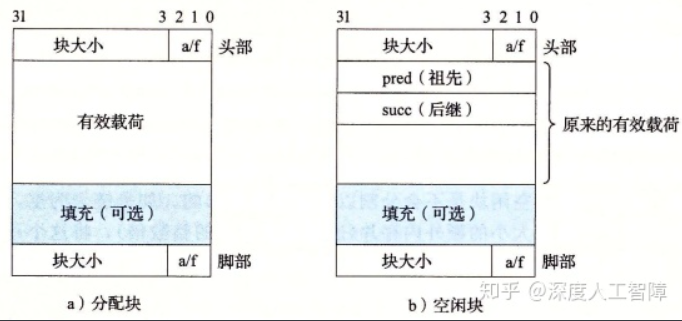
Here, the free block records the precursor and subsequent free blocks of the free block in the second word and the third word. Therefore, all free blocks can be displayed and linked through the pointer, and all free blocks can be traversed directly through the pointer.
We define the following macros
//Word size and doubleword size #define WSIZE 4 #define DSIZE 8 //The heap space requested from the kernel when the heap memory is insufficient #define CHUNKSIZE (1<<12) //Put val into the 4 bytes beginning with p #define PUT(p,val) (*(unsigned int*)(p) = (val)) #define GET(p) (*(unsigned int*)(p)) //Get head and foot coding #define PACK(size, alloc) ((size) | (alloc)) //Obtain block size and allocated bits from the head or feet #define GET_SIZE(p) (GET(p) & ~0x7) #define GET_ALLO(p) (GET(p) & 0x1) //Get the head and feet of the block #define HDRP(bp) ((char*)(bp) - WSIZE) #define FTRP(bp) ((char*)(bp) + GET_SIZE(HDRP(bp)) - DSIZE) //Gets the previous block and the next block #define NEXT_BLKP(bp) ((char*)(bp) + GET_SIZE(HDRP(bp))) #define PREV_BLKP(bp) ((char*)(bp) - GET_SIZE((char*)(bp) - DSIZE)) //Obtain the address of the successor and predecessor recorded in the block #define PRED(bp) ((char*)(bp) + WSIZE) #define SUCC(bp) ((char*)bp) //Obtain the addresses of the successors and precursors of the block #define PRED_BLKP(bp) (GET(PRED(bp))) #define SUCC_BLKP(bp) (GET(SUCC(bp))) #define MAX(x,y) ((x)>(y)?(x):(y))
Here bp points to the position of a word behind the header. We use the first word to record the subsequent address of the free block and the second block to record the address of the precursor. Why? It will be explained later.
Then we need to determine the size class of the separated free linked list. Since a free block contains the head, successor, precursor and foot, and needs at least 16 bytes, the minimum block of the free block is 16 bytes. If it is less than 16 bytes, the complete free block content cannot be recorded, so the size class is set to
{16-31},{32-63},{64-127},{128-255},{256-511},{512-1023},{1024-2047},{2048-4095},{4096-inf}
We need to include the root node of these size classes at the beginning of the heap and point to their corresponding free linked list, so the root needs a word of space to save the address. Secondly, you still need to save the preamble block and the ending block as a flag for moving between blocks. So mm_init is as follows
static char *heap_listp;
static char *listp;
/*
* mm_init - initialize the malloc package.
*/
int mm_init(void){
if((heap_listp = mem_sbrk(12*WSIZE)) == (void*)-1)
return -1;
//The smallest block of the free block contains the head, precursor, successor and foot, with 16 bytes
PUT(heap_listp+0*WSIZE, NULL); //{16~31}
PUT(heap_listp+1*WSIZE, NULL); //{32~63}
PUT(heap_listp+2*WSIZE, NULL); //{64~127}
PUT(heap_listp+3*WSIZE, NULL); //{128~255}
PUT(heap_listp+4*WSIZE, NULL); //{256~511}
PUT(heap_listp+5*WSIZE, NULL); //{512~1023}
PUT(heap_listp+6*WSIZE, NULL); //{1024~2047}
PUT(heap_listp+7*WSIZE, NULL); //{2048~4095}
PUT(heap_listp+8*WSIZE, NULL); //{4096~inf}
//Or do you want to include a preamble block and an ending block
PUT(heap_listp+9*WSIZE, PACK(DSIZE, 1));
PUT(heap_listp+10*WSIZE, PACK(DSIZE, 1));
PUT(heap_listp+11*WSIZE, PACK(0, 1));
listp = heap_listp;
heap_listp += 10*WSIZE;
if(expend_heap(CHUNKSIZE/WSIZE) == NULL)
return -1;
return 0;
}
Here, we first apply for a space of 12 words, and then the next 9 save the root pointers of each size class in turn, initially NULL. Then, the last three words are used to save the preamble block and the ending block. Let listp point to the starting position of the size class array and heap_listp points to the payload of the preamble block, and then calls expend_. Heap to request heap space** Note: * * the root pointer is equivalent to only subsequent blocks, so you can view subsequent blocks through the SUCC macro.
static void *expend_heap(size_t words){
size_t size;
void *bp;
size = words%2 ? (words+1)*WSIZE : words*WSIZE;
if((bp = mem_sbrk(size)) == (void*)-1)
return NULL;
PUT(HDRP(bp), PACK(size, 0));
PUT(FTRP(bp), PACK(size, 0));
PUT(HDRP(NEXT_BLKP(bp)), PACK(0, 1));
PUT(PRED(bp), NULL);
PUT(SUCC(bp), NULL);
//Merge now
bp = imme_coalesce(bp);
bp = add_block(bp);
return bp;
}
First, get the aligned size, and then set the head, foot and end blocks of the free block like the implicit free linked list. Then, since the free block has not been inserted into the free list, the first and subsequent pointer of the free block is set to NULL first, and then the imme_ is called. The coalesce function merges the free blocks immediately, and then calls add_ The block function inserts the free block into the free linked list of the appropriate size class.
static void *imme_coalesce(void *bp){
size_t prev_alloc = GET_ALLO(FTRP(PREV_BLKP(bp)));
size_t next_alloc = GET_ALLO(HDRP(NEXT_BLKP(bp)));
size_t size = GET_SIZE(HDRP(bp));
if(prev_alloc && next_alloc){
return bp;
}else if(prev_alloc && !next_alloc){
size += GET_SIZE(HDRP(NEXT_BLKP(bp)));
delete_block(NEXT_BLKP(bp));
PUT(HDRP(bp), PACK(size, 0));
PUT(FTRP(bp), PACK(size, 0));
}else if(!prev_alloc && next_alloc){
size += GET_SIZE(FTRP(PREV_BLKP(bp)));
delete_block(PREV_BLKP(bp));
PUT(HDRP(PREV_BLKP(bp)), PACK(size, 0));
PUT(FTRP(bp), PACK(size, 0));
bp = PREV_BLKP(bp);
}else{
size += GET_SIZE(HDRP(NEXT_BLKP(bp))) +
GET_SIZE(FTRP(PREV_BLKP(bp)));
delete_block(NEXT_BLKP(bp));
delete_block(PREV_BLKP(bp));
PUT(HDRP(PREV_BLKP(bp)), PACK(size, 0));
PUT(FTRP(NEXT_BLKP(bp)), PACK(size, 0));
bp = PREV_BLKP(bp);
}
return bp;
}
Firstly, the allocated bits of adjacent blocks before and after the free block bp are found, which are divided into four cases according to the combination of allocated bits.
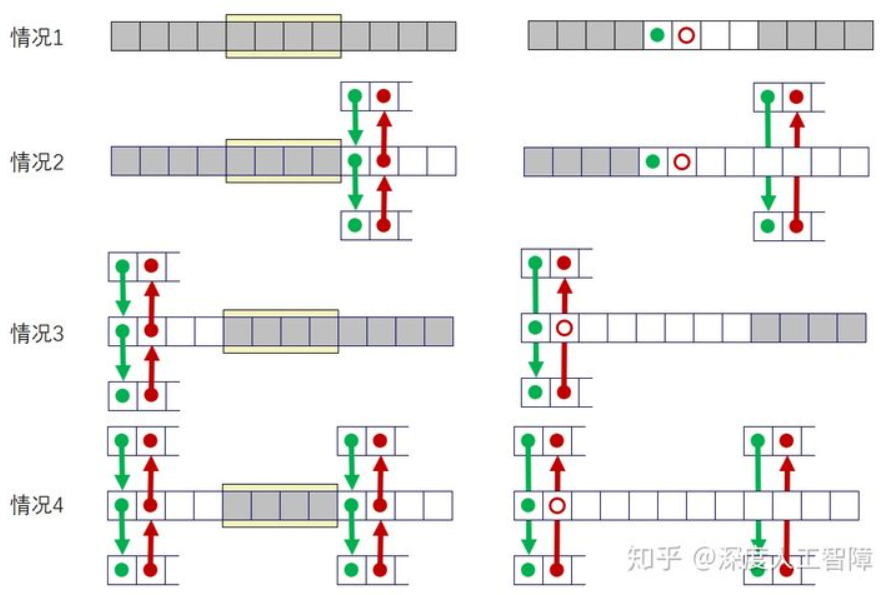
It can be found that if there are free blocks around, you need to delete them first_ The block function removes the free block from the display free list and adjusts the part of the pointer in the graph, then sets the corresponding head and foot, so that the free block is merged and bp points to the payload part of the new free block.
static void delete_block(void *bp){
PUT(SUCC(PRED_BLKP(bp)), SUCC_BLKP(bp));
if(SUCC_BLKP(bp)!=NULL)
PUT(PRED(SUCC_BLKP(bp)), PRED_BLKP(bp));
}
Deleting the specified free block from the displayed free linked list is actually very simple. It is just to adjust the pointers of the precursor and successor to skip the current free block.
After merging the free blocks, we need to insert them into the display free linked list of appropriate size classes
static void *add_block(void *bp){
size_t size = GET_SIZE(HDRP(bp));
int index = Index(size);
void *root = listp+index*WSIZE;
//LIFO
return LIFO(bp, root);
//AddressOrder
//return AddressOrder(bp, root);
}
When inserting a free block into the display free linked list, you first need to determine the size class of the free block
static int Index(size_t size){
int ind = 0;
if(size >= 4096)
return 8;
size = size>>5;
while(size){
size = size>>1;
ind++;
}
return ind;
}
Thus, the root pointer of the display free linked list corresponding to the size class can be obtained. At this time, two strategies for inserting free blocks in the display free linked list are provided: LIFO strategy and address order strategy.
static void *LIFO(void *bp, void *root){
if(SUCC_BLKP(root)!=NULL){
PUT(PRED(SUCC_BLKP(root)), bp); //SUCC->BP
PUT(SUCC(bp), SUCC_BLKP(root)); //BP->SUCC
}else{
PUT(SUCC(bp), NULL); //Missing this!!!!
}
PUT(SUCC(root), bp); //ROOT->BP
PUT(PRED(bp), root); //BP->ROOT
return bp;
}
LIFO strategy is to insert free blocks directly into the header node. Note that when there is no successor node after root, it means that bp is directly found after root. At this time, remember to set the successor node of bp to NULL.
static void *AddressOrder(void *bp, void *root){
void *succ = root;
while(SUCC_BLKP(succ) != NULL){
succ = SUCC_BLKP(succ);
if(succ >= bp){
break;
}
}
if(succ == root){
return LIFO(bp, root);
}else if(SUCC_BLKP(succ) == NULL){
PUT(SUCC(succ), bp);
PUT(PRED(bp), succ);
PUT(SUCC(bp), NULL);
}else{
PUT(SUCC(PRED_BLKP(succ)), bp);
PUT(PRED(bp), PRED_BLKP(succ));
PUT(SUCC(bp), succ);
PUT(PRED(succ), bp);
}
return bp;
}
The address order is to make the free block addresses in the displayed free linked list increase in turn. The first adaptation of this strategy will have higher memory utilization than the first adaptation of LIFO.
Then we can look at our mm_malloc function
void *mm_malloc(size_t size){
size_t asize;
void *bp;
if(size == 0)
return NULL;
//Meet the minimum block requirements and alignment requirements, and size is the payload size
asize = size<=DSIZE ? 2*DSIZE : DSIZE * ((size + (DSIZE) + (DSIZE-1)) / DSIZE);
//First match
if((bp = first_fit(asize)) != NULL){
place(bp, asize);
return bp;
}
//Best match
/*if((bp = best_fit(asize)) != NULL){
place(bp, asize);
return bp;
}*/
if((bp = expend_heap(MAX(CHUNKSIZE, asize)/WSIZE)) == NULL)
return NULL;
place(bp, asize);
return bp;
}
First, calculate the size of the free block that meets the minimum block and its requirements, * * Note: * * the free block needs two additional words to save the precursor and subsequent pointers, but the allocated block does not need it, so the asize here is still the same as that of the implicit free linked list.
Two strategies, first matching and best matching, are provided here
static void *first_fit(size_t asize){
int ind = Index(asize);
void *succ;
while(ind <= 8){
succ = listp+ind*WSIZE;
while((succ = SUCC_BLKP(succ)) != NULL){
if(GET_SIZE(HDRP(succ)) >= asize && !GET_ALLO(HDRP(succ))){
return succ;
}
}
ind+=1;
}
return NULL;
}
In the first matching, first determine the size class of the idle block of asize size, and then search the display idle linked list corresponding to the size class. If an idle block of appropriate size is found, it will return directly. If the display idle linked list does not find an appropriate idle block, it will traverse the display idle linked list of the next size class, Because the free block of the next size class must be larger than that of the current size class.
static void *best_fit(size_t asize){
int ind = Index(asize);
void *best = NULL;
int min_size = 0, size;
void *succ;
while(ind <= 8){
succ = listp+ind*WSIZE;
while((succ = SUCC_BLKP(succ)) != NULL){
size = GET_SIZE(HDRP(succ));
if(size >= asize && !GET_ALLO(HDRP(succ)) && (size<min_size||min_size==0)){
best = succ;
min_size = size;
}
}
if(best != NULL)
return best;
ind+=1;
}
return NULL;
}
The best fit is to find the smallest free block that meets the size requirements.
When a suitable free block is found, we need to call the place function to use the free block
static void place(void *bp, size_t asize){
size_t remain_size;
remain_size = GET_SIZE(HDRP(bp)) - asize;
delete_block(bp);
if(remain_size >= DSIZE*2){ //division
PUT(HDRP(bp), PACK(asize, 1));
PUT(FTRP(bp), PACK(asize, 1));
PUT(HDRP(NEXT_BLKP(bp)), PACK(remain_size, 0));
PUT(FTRP(NEXT_BLKP(bp)), PACK(remain_size, 0));
add_block(NEXT_BLKP(bp));
}else{
PUT(HDRP(bp), PACK(GET_SIZE(HDRP(bp)), 1));
PUT(FTRP(bp), PACK(GET_SIZE(HDRP(bp)), 1));
}
}
In the place function, we first delete the free block from the displayed free linked list, and then judge whether the remaining space meets the minimum requirements of the free block. If so, divide the free block, and then call add for the remaining free blocks_ The block function puts it into the display free linked list of appropriate size classes. If the remaining space is not enough to form a free block, the whole free block is directly used.
Next, let's take a look at our mm_ The free function
/*
* mm_free - Freeing a block does nothing.
*/
void mm_free(void *ptr){
size_t size = GET_SIZE(HDRP(ptr));
PUT(HDRP(ptr), PACK(size, 0));
PUT(FTRP(ptr), PACK(size, 0));
//Merge now
ptr = imme_coalesce(ptr);
add_block(ptr);
}
The function first modifies the head and foot of the allocated block, then sets it to the free block, and then calls imme_. The coalesce function is merged immediately, and then add_ is called. The block function inserts it into the appropriate position in the display free linked list of the appropriate size class.
Next, let's look at our mm_realloc function
/*
* mm_realloc - Implemented simply in terms of mm_malloc and mm_free
*/
void *mm_realloc(void *ptr, size_t size){
size_t asize, ptr_size, remain_size;
void *new_bp;
if(ptr == NULL){
return mm_malloc(size);
}
if(size == 0){
mm_free(ptr);
return NULL;
}
asize = size<=DSIZE ? 2*DSIZE : DSIZE * ((size + (DSIZE) + (DSIZE-1)) / DSIZE);
new_bp = imme_coalesce(ptr); //Try if you have free
ptr_size = GET_SIZE(HDRP(new_bp));
PUT(HDRP(new_bp), PACK(ptr_size, 1));
PUT(FTRP(new_bp), PACK(ptr_size, 1));
if(new_bp != ptr)
memcpy(new_bp, ptr, GET_SIZE(HDRP(ptr)) - DSIZE);
if(ptr_size == asize){
return new_bp;
}else if(ptr_size > asize){
remain_size = ptr_size - asize;
if(remain_size >= DSIZE*2){ //division
PUT(HDRP(new_bp), PACK(asize, 1));
PUT(FTRP(new_bp), PACK(asize, 1));
PUT(HDRP(NEXT_BLKP(new_bp)), PACK(remain_size, 0));
PUT(FTRP(NEXT_BLKP(new_bp)), PACK(remain_size, 0));
add_block(NEXT_BLKP(new_bp));
}
return new_bp;
}else{
if((ptr = mm_malloc(asize)) == NULL)
return NULL;
memcpy(ptr, new_bp, ptr_size - DSIZE);
mm_free(new_bp);
return ptr;
}
}
Here is the same idea as before.
Secondly, discrete free linked lists are prone to errors in pointers. Here is a code for displaying free linked lists of various sizes to detect whether there are pointer errors
static void print_listp(){
int ind;
void *node, *root;
printf("print listp\n");
for(ind=1;ind<=8;ind++){
node = listp+ind*WSIZE;
root = listp+ind*WSIZE;
printf("%d:\n",ind);
while(SUCC_BLKP(node)){
node = SUCC_BLKP(node);
printf("-->%p,%d",node, GET_SIZE(HDRP(node)));
}
printf("-->%p\n",SUCC_BLKP(node));
while(node!=root){
printf("<--%p,%d",node, GET_SIZE(HDRP(node)));
node = PRED_BLKP(node);
}
printf("<--%p\n",node);
}
}
Then here are the experimental results
Merge now + first fit + LIFO:
trace valid util ops secs Kops 0 yes 98% 5694 0.000925 6158 1 yes 94% 5848 0.001066 5487 2 yes 98% 6648 0.001315 5054 3 yes 99% 5380 0.000914 5887 4 yes 66% 14400 0.001441 9991 5 yes 89% 4800 0.001068 4495 6 yes 85% 4800 0.001189 4037 7 yes 55% 12000 0.001854 6474 8 yes 51% 24000 0.003982 6027 9 yes 48% 14401 0.153353 94 10 yes 45% 14401 0.034466 418 Total 75% 112372 0.201572 557 Perf index = 45 (util) + 37 (thru) = 82/100
Merge now + best fit + LIFO:
Results for mm malloc: trace valid util ops secs Kops 0 yes 99% 5694 0.001026 5548 1 yes 99% 5848 0.001052 5558 2 yes 99% 6648 0.001170 5682 3 yes 100% 5380 0.001103 4878 4 yes 66% 14400 0.001601 8993 5 yes 96% 4800 0.002048 2344 6 yes 95% 4800 0.001930 2487 7 yes 55% 12000 0.001934 6206 8 yes 51% 24000 0.004590 5229 9 yes 40% 14401 0.004290 3357 10 yes 45% 14401 0.003162 4555 Total 77% 112372 0.023907 4700 Perf index = 46 (util) + 40 (thru) = 86/100
Merge now + best fit + AddressOrder:
Results for mm malloc: trace valid util ops secs Kops 0 yes 99% 5694 0.001086 5244 1 yes 99% 5848 0.001069 5473 2 yes 99% 6648 0.001304 5097 3 yes 100% 5380 0.001135 4738 4 yes 66% 14400 0.001509 9544 5 yes 96% 4800 0.003104 1546 6 yes 95% 4800 0.003175 1512 7 yes 55% 12000 0.020766 578 8 yes 51% 24000 0.071639 335 9 yes 40% 14401 0.004262 3379 10 yes 45% 14401 0.003016 4775 Total 77% 112372 0.112065 1003 Perf index = 46 (util) + 40 (thru) = 86/100
Merge now + first fit + AddressOrder:
Results for mm malloc: trace valid util ops secs Kops 0 yes 99% 5694 0.000945 6023 1 yes 99% 5848 0.001001 5843 2 yes 99% 6648 0.001177 5649 3 yes 100% 5380 0.000948 5676 4 yes 66% 14400 0.001481 9720 5 yes 93% 4800 0.002984 1608 6 yes 91% 4800 0.002907 1651 7 yes 55% 12000 0.020213 594 8 yes 51% 24000 0.070960 338 9 yes 40% 14401 0.004211 3420 10 yes 45% 14401 0.002934 4908 Total 76% 112372 0.109762 1024 Perf index = 46 (util) + 40 (thru) = 86/100
Show free linked list
This time, malloc lab wrote a memory allocator by itself.
1. Experimental purpose
malloclab, in short, is to implement its own malloc, free and realloc functions. After this experiment, you can deepen your understanding of pointers and master some core concepts in memory allocation, such as how to organize heap, how to find available free block s, and adopt first fit, next fit and best fit? How to trade off between throughput and memory utilization.
In my personal opinion, the basic knowledge of malloclab is not difficult, but the code is full of a large number of pointer operations. In order to avoid hard coding pointer operations, some macros will be defined, Defining macros to operate will increase the difficulty of debugging (of course, great gods such as linus will think, why use debug when the code is written?). Debugging can only rely on gdb and print, so it is still difficult as a whole.
2. Background knowledge
Here is a brief introduction to the background knowledge needed to do this experiment.
First, what problems need to be solved in order to write an allocator. csapp some key issues are listed in the ppt in this chapter:
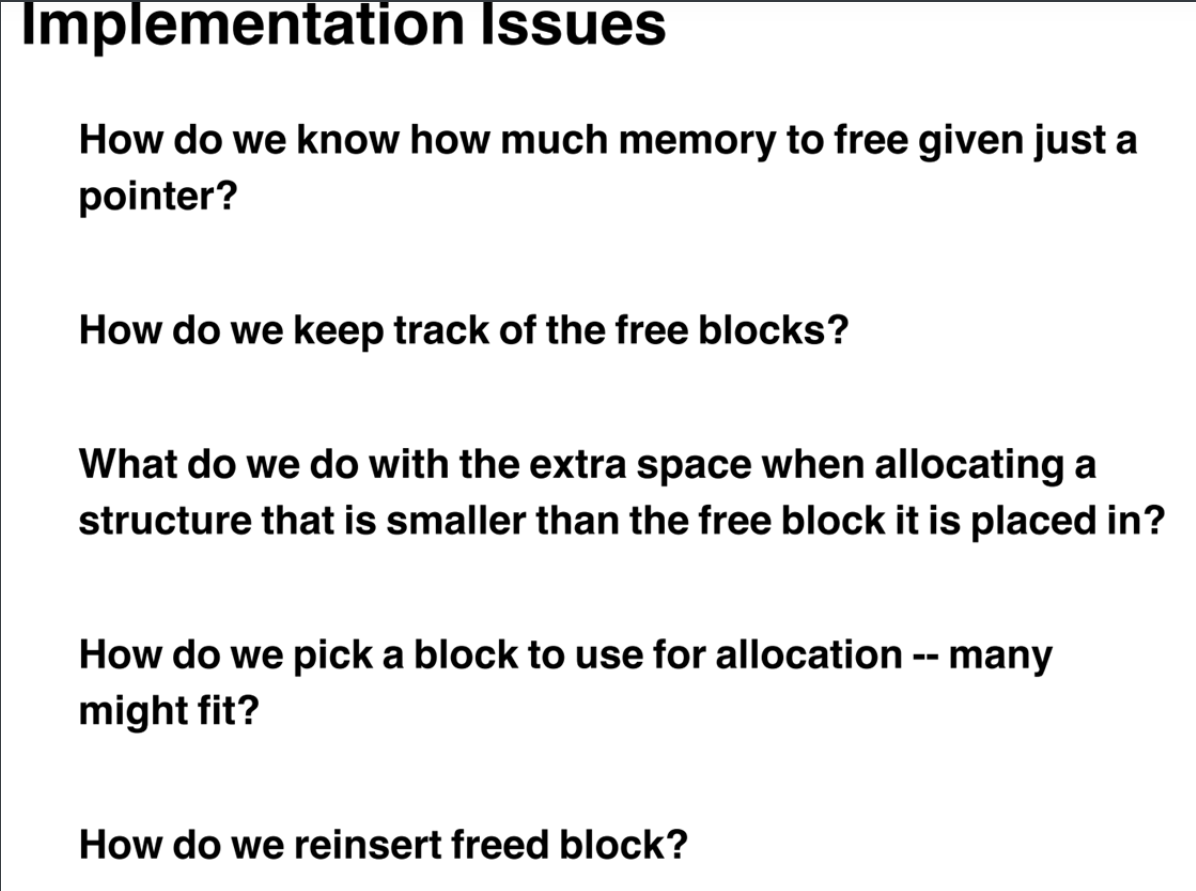
The first question is, how does a route like free (ptr) know the size of the block released this time?
Obviously, we need some additional information to store the meta information of the block. The specific method is to add a word in front of the block to store the allocated size and whether it has been allocated.
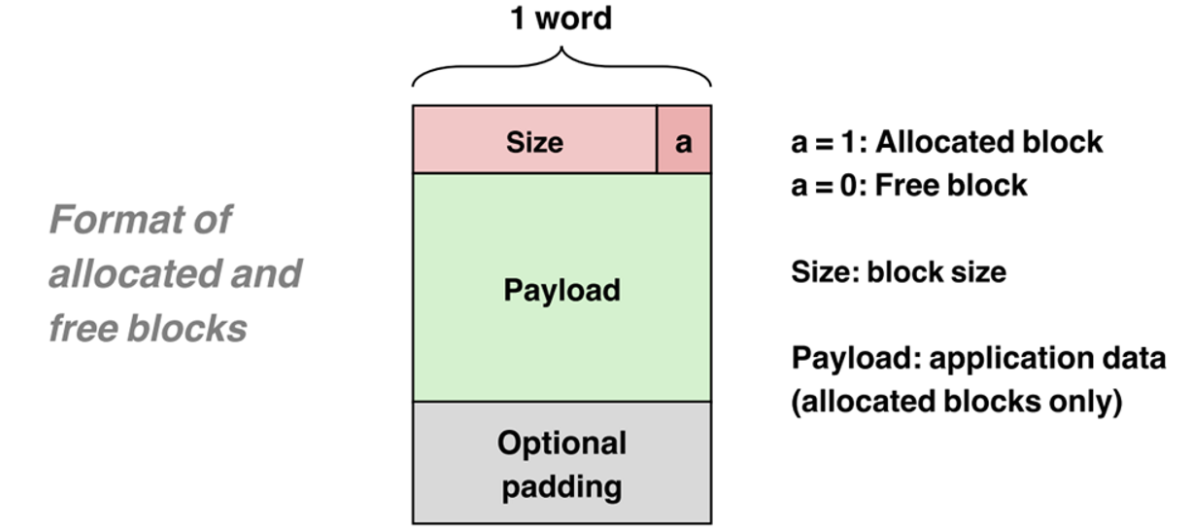
Note: This is only the simplest case. In practice, these are not the only additional metadata
The second question, how to track free blocks?
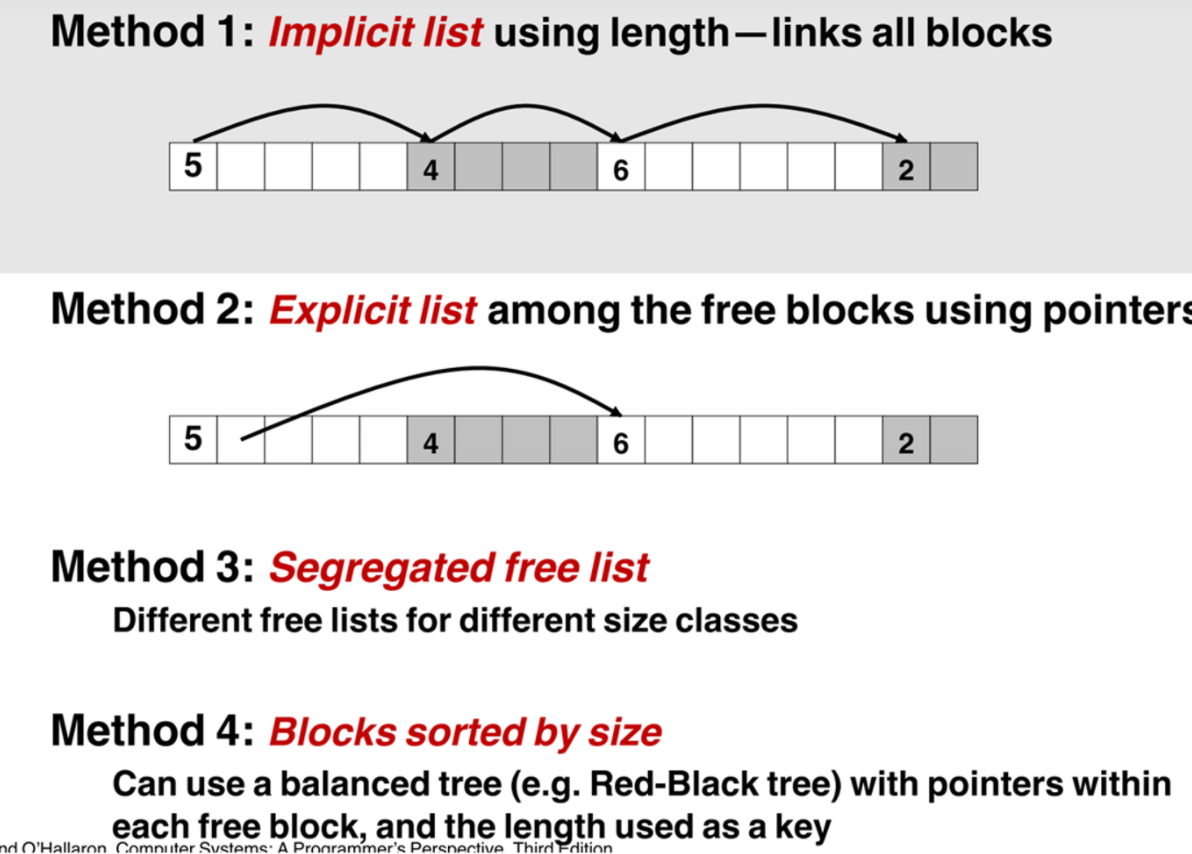
csapp gives a total of four schemes. The source code of implicit list is given in the book. I personally implemented implicit list and explicit list. The aggregated free list feels that it is possible to encapsulate the explicit list by using the OO idea. The same is true for red and black trees.
The third problem is the split strategy (see the place function of the code for details)
The fourth question, generally speaking, there are first fit, next fit and best fit strategies. I use the simplest first fit strategy here. (this is actually a trade-off problem. It depends on whether you want high throughput or high memory utilization.)
ok, let's take a look at how the implicit list and explicit list are implemented.
3. Implicit list
The following is the organization of an implicit list and the specific situation of a block. A block adopts a bilateral tag to ensure forward and backward indexing.
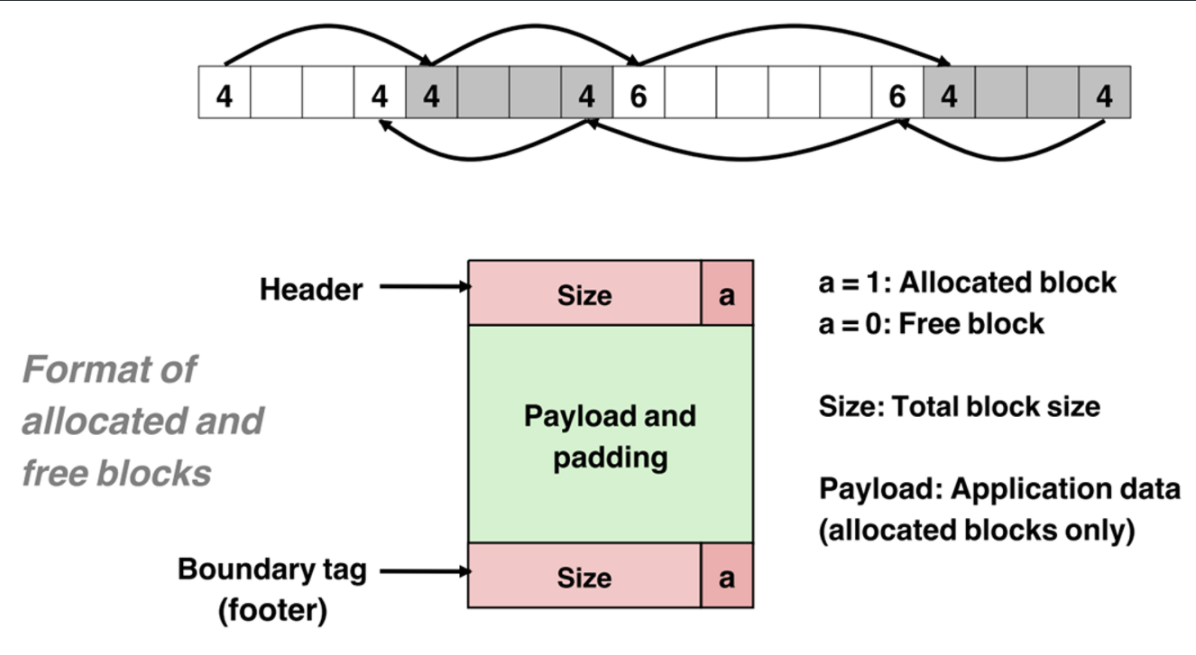
The advantages of this scheme: simple implementation. Disadvantages: the cost of finding free block is too large.
Now let's talk about some codes given in lab:
- memlib, this file gives the method of heap extension. In addition, we can also get the first byte, the last byte, heap size, etc. of the currently available heap. The specific implementation is operated through an sbrk pointer.
- mdriver, this file does not need to be read, but only the executable file compiled by it, which is used to test whether the allocator we write is correct.
- mm.c. This is the file we want to operate. It mainly implements three functions mm_malloc,mm_free,mm_realloc, we define additional functions we need.
OK, let's talk about the specific code, because many pointer operations are involved in the code. We make a peak installation for these operations and use macro definitions to operate them:
#define WSIZE 4 /* Word and header/footer size (bytes) */ #define DSIZE 8 /* Double word size (bytes) */ #define CHUNKSIZE (1<<12) /* Extend heap by this amount (bytes) */ #define MAX(x, y) ((x) > (y)? (x) : (y)) /* Pack a size and allocated bit into a word */ #define PACK(size, alloc) ((size) | (alloc)) /* Read and write a word at address p */ #define GET(p) (*(unsigned int *)(p)) #define PUT(p, val) (*(unsigned int *)(p) = (val)) /* Read the size and allocated fields from address p */ #define GET_SIZE(p) (GET(p) & ~0x7) #define GET_ALLOC(p) (GET(p) & 0x1) /* Given block ptr bp, compute address of its header and footer */ #define HDRP(bp) ((char *)(bp) - WSIZE) #define FTRP(bp) ((char *)(bp) + GET_SIZE(HDRP(bp)) - DSIZE) /* Given block ptr bp, compute address of next and previous blocks */ #define NEXT_BLKP(bp) ((char *)(bp) + GET_SIZE(((char *)(bp) - WSIZE))) #define PREV_BLKP(bp) ((char *)(bp) - GET_SIZE(((char *)(bp) - DSIZE)))
Comments give the meaning of each macro.
Some additional definitions:
static void *free_list_head = NULL; // The head of the whole list static void *extend_heap(size_t words); // Used to expand the heap size when the heap is not allocated enough static void *coalesce(void *bp); // During free block, there may be some situations where the front and back are also free blocks. At this time, it is necessary to merge. It is not allowed to have two consecutive free blocks on a list at the same time static void *find_fit(size_t size); // Find the block on the list that can satisfy the malloc request static void place(void *bp, size_t size); // Place the current block, if size < current block size - MIN_BLOCK, split is required
mm_init
This function initializes mm, including:
- Four words are allocated, and the 0th word is pad. For the subsequent allocated block, the first address of payload can be 8-byte aligned.
- Words 1-2 are the preamble block, free_list_head points here, which is equivalent to giving a definition to list. Otherwise, where do we start search?
- The third word, the ending block, is mainly used to determine the tail boundary.
- extend_heap: allocate a large heap for subsequent malloc requests.
/*
* mm_init - initialize the malloc package.
*/
int mm_init(void)
{
// Create the inital empty heap
if( (free_list_head = mem_sbrk(4 * WSIZE)) == (void *)-1 ){
return -1;
}
PUT(free_list_head, 0);
PUT(free_list_head + (1 * WSIZE), PACK(DSIZE, 1));
PUT(free_list_head + (2 * WSIZE), PACK(DSIZE, 1));
PUT(free_list_head + (3 * WSIZE), PACK(0, 1));
free_list_head += (2 * WSIZE);
// Extend the empty heap with a free block of CHUNKSIZE bytes
if(extend_heap(CHUNKSIZE/WSIZE) == NULL){
return -1;
}
return 0;
}
extend_heap
Work:
- Update the size to ensure that the size is an even number of word s
- Add metadata for the currently allocated block, that is, header and footer information
- Update tail boundary
static void *extend_heap(size_t words)
{
char *bp;
size_t size;
/* Allocate an even number of words to maintain alignment */
size = (words % 2) ? (words + 1) * WSIZE : words * WSIZE;
if( (long)(bp = mem_sbrk(size)) == -1 ){
return NULL;
}
// Initialize header/footer and epilogue header of free block
PUT(HDRP(bp), PACK(size, 0));
PUT(FTRP(bp), PACK(size, 0));
PUT(HDRP(NEXT_BLKP(bp)), PACK(0, 1));
// Coalesce if the previous block was free
return coalesce(bp);
}
mm_malloc
mm_malloc is also relatively simple. First, change the request size to meet the overhead requirements of 8-byte alignment + metadata. Then try to find out whether there is a block in the currently available heap that can meet the request. If there is, place directly. If not, expand the size of the currently available heap and then place.
/*
* mm_malloc - Allocate a block by incrementing the brk pointer.
* Always allocate a block whose size is a multiple of the alignment.
*/
void *mm_malloc(size_t size)
{
size_t asize; // Adjusted block size
size_t extendsize; // Amount to extend heap if no fit
char *bp;
if (size == 0)
return NULL;
// Ajust block size to include overhea and alignment reqs;
if (size <= DSIZE)
{
asize = 2 * DSIZE;
}
else
{
asize = DSIZE * ((size + (DSIZE) + (DSIZE - 1)) / DSIZE); // If it exceeds 8 bytes, plus the overhead of header/footer block, the upward rounding is guaranteed to be a multiple of 8
}
// Search the free list for a fit
if ((bp = find_fit(asize)) != NULL)
{
place(bp, asize);
}
else
{
// No fit found. Get more memory and place the block
extendsize = MAX(asize, CHUNKSIZE);
if ((bp = extend_heap(extendsize / WSIZE)) == NULL)
{
return NULL;
}
place(bp, asize);
}
#ifdef DEBUG
printf("malloc\n");
print_allocated_info();
#endif
return bp;
}
find_fit
Traverse the whole list, find the block that has not been allocated and meets the current request size, and then return the first address of the block.
/**
* @brief Use first fit policy
*
* @param size
* @return void* If successful, the first address of the available block is returned
* Failed, NULL returned
*/
static void *find_fit(size_t size)
{
void *bp ;
for (bp = NEXT_BLKP(free_list_head); GET_SIZE(HDRP(bp)) > 0; bp = NEXT_BLKP(bp))
{
if(GET_ALLOC(HDRP(bp)) == 0 && size <= GET_SIZE(HDRP(bp)))
{
return bp;
}
}
return NULL;
}
place
The work of place is also simple:
- Minimum block size (2 * dsize) < = current block size - current requested block size, split the current block
- Otherwise, place directly.
Now continue to look at free:
/**
* @brief place block
*
* @param bp
* @param size
*/
static void place(void *bp, size_t size)
{
size_t remain_size;
size_t origin_size;
origin_size = GET_SIZE(HDRP(bp));
remain_size = origin_size - size;
if(remain_size >= 2*DSIZE) // For the remaining blocks, at least one double word is required (header / footer occupies a double word, pyaload is not empty, plus alignment requirements)
{
PUT(HDRP(bp), PACK(size, 1));
PUT(FTRP(bp), PACK(size, 1));
PUT(HDRP(NEXT_BLKP(bp)), PACK(remain_size, 0));
PUT(FTRP(NEXT_BLKP(bp)), PACK(remain_size, 0));
}else{
// Less than one double word, keep the internal fragment
PUT(HDRP(bp), PACK(origin_size, 1));
PUT(FTRP(bp), PACK(origin_size, 1));
}
}
mm_free
As you can see, free is also quite simple. You can update the allocation status of the current block from 1 to 0. Then do the coalesce operation:
/*
* mm_free - Freeing a block does nothing.
*/
void mm_free(void *ptr)
{
size_t size = GET_SIZE(HDRP(ptr));
PUT(HDRP(ptr), PACK(size, 0));
PUT(FTRP(ptr), PACK(size, 0));
coalesce(ptr);
#ifdef DEBUG
printf("free\n");
print_allocated_info();
#endif
}
coalesce
After free block, consider whether there are free blocks before and after. If there are free blocks, they need to be merged. Four cases are given below:
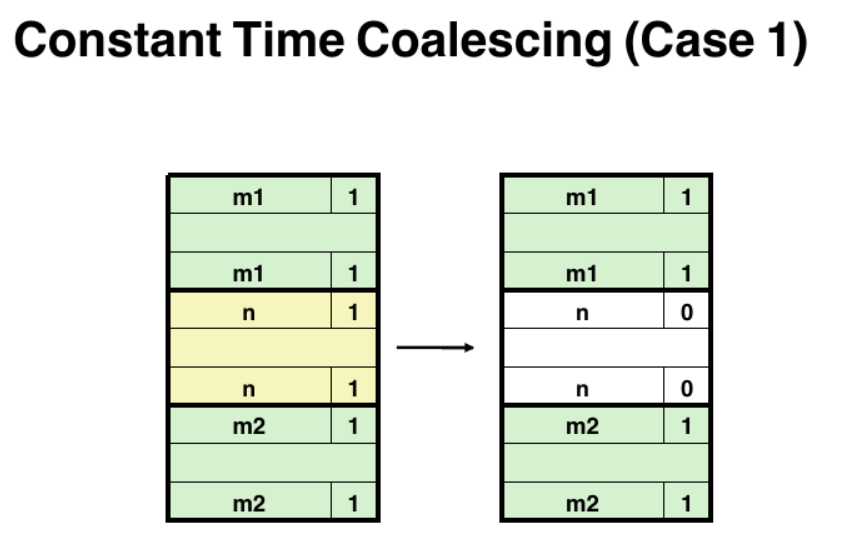
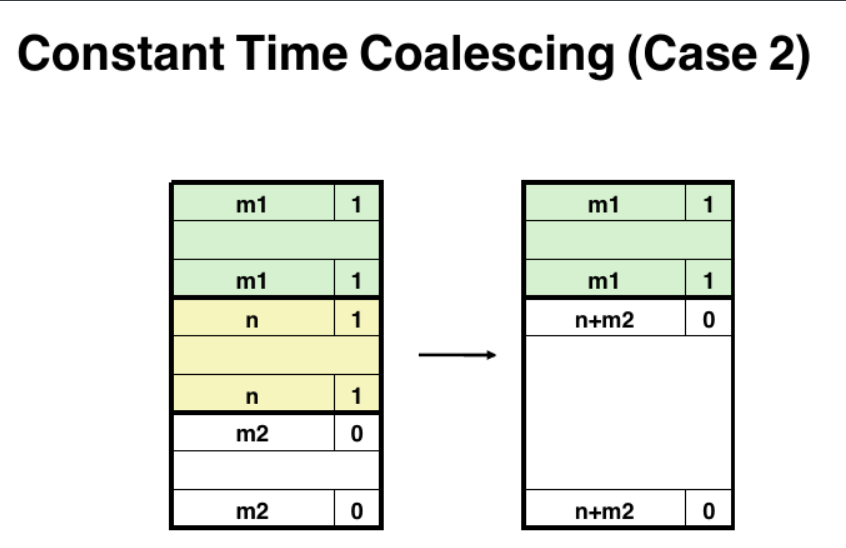
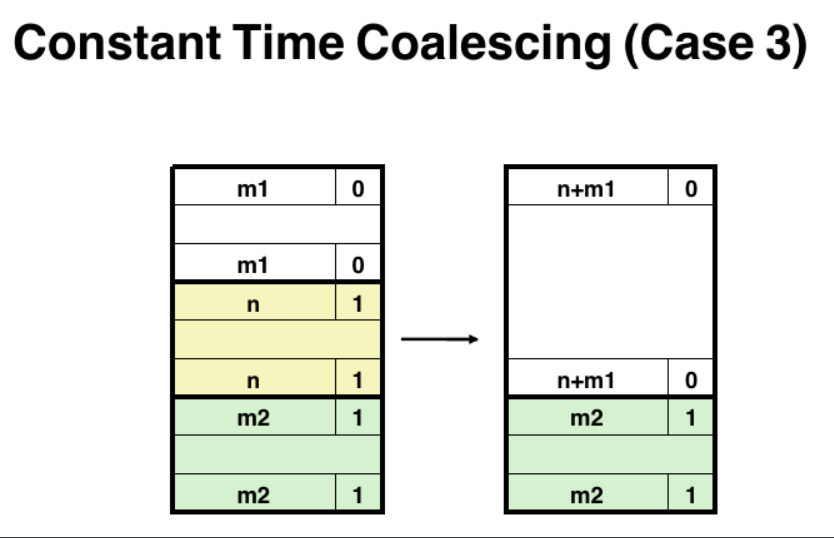
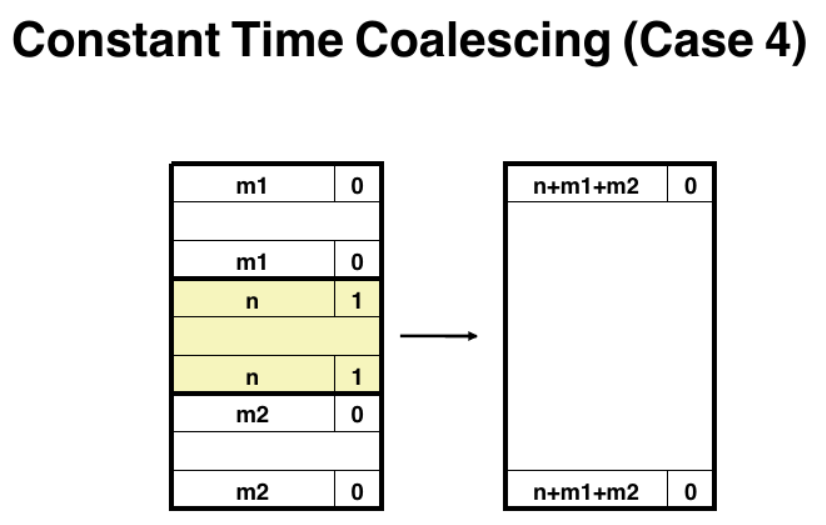
// Due to the existence of preamble and tail blocks, some boundary checks are avoided.
static void *coalesce(void *bp)
{
size_t pre_alloc = GET_ALLOC(HDRP(PREV_BLKP(bp)));
size_t next_alloc = GET_ALLOC(HDRP(NEXT_BLKP(bp)));
size_t size = GET_SIZE(HDRP(bp));
if(pre_alloc && next_alloc){ // case1: both front and back allocation
return bp;
}
else if(pre_alloc && !next_alloc){ // case 2: pre allocation, post free
void *next_block = NEXT_BLKP(bp);
size += GET_SIZE(HDRP(next_block));
PUT(HDRP(bp), PACK(size, 0));
PUT(FTRP(next_block), PACK(size, 0));
// TODO: don't empty the other two tag s? Under normal circumstances, there is really no need to empty.
}
else if(!pre_alloc && next_alloc){ // case 3: pre free, post allocation
size += GET_SIZE(HDRP(PREV_BLKP(bp)));
PUT(FTRP(bp), PACK(size, 0));
PUT(HDRP(PREV_BLKP(bp)), PACK(size, 0));
bp = PREV_BLKP(bp);
}
else { // Both are free
size += GET_SIZE(HDRP(PREV_BLKP(bp))) +
GET_SIZE(FTRP(NEXT_BLKP(bp)));
PUT(HDRP(PREV_BLKP(bp)), PACK(size, 0));
PUT(FTRP(NEXT_BLKP(bp)), PACK(size, 0));
bp = PREV_BLKP(bp);
}
return bp;
}
mm_realloc
Realloc function implementation is also very simple, realloc redistributes size blocks, and then copies the old block content to the new block content. Note that the smaller block is also considered here
/*
* mm_realloc - Implemented simply in terms of mm_malloc and mm_free
*/
void *mm_realloc(void *ptr, size_t size)
{
void *oldptr = ptr;
void *newptr;
size_t copySize;
newptr = mm_malloc(size);
if (newptr == NULL)
return NULL;
copySize = GET_SIZE(HDRP(oldptr));
if (size < copySize)
copySize = size;
memcpy(newptr, oldptr, copySize);
mm_free(oldptr);
return newptr;
}
ok, the above is all about implicit list. Let's start to explain the implementation of explicit list
4. explicit list
The difference between explicit list and implicit list is that the former maintains a free list in the logical space, which only stores free blocks, while the latter maintains the whole list in the virtual address space, which contains both free blocks and allocated blocks Of course, the underlying layer of explicit list is also a virtual address space. The following figure shows the upper structure of explicit list:
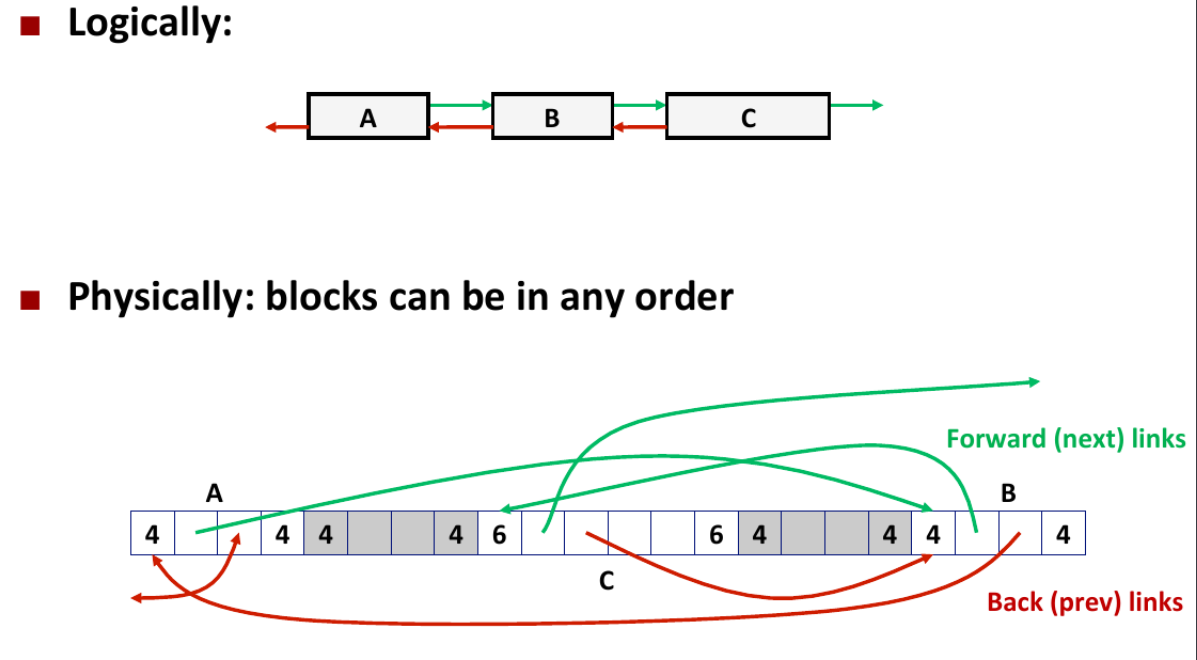
The specific structure comparison of each block of implicit and explicit is given below:
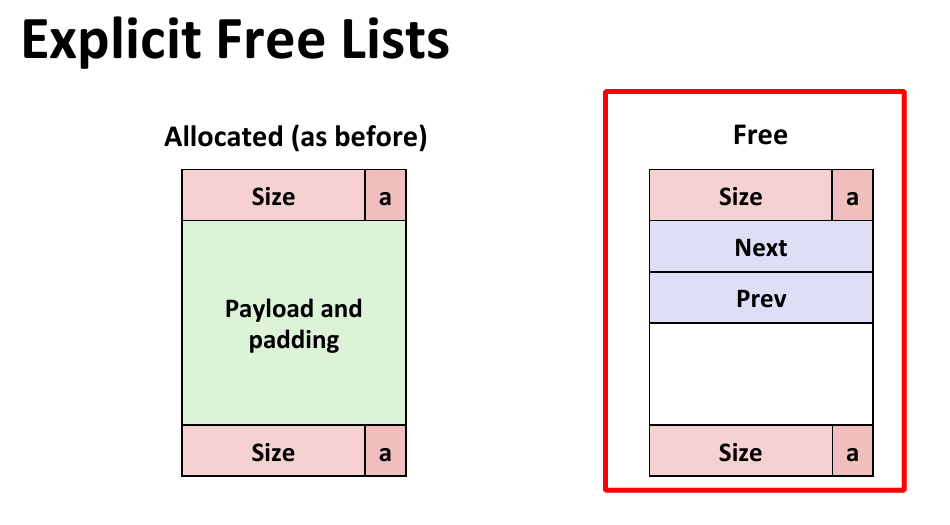
As you can see, explicit is more implicit. Each block has only two additional fields, which are used to save the address of the next free block (next) and the address of the previous free block (prev)
Consider the advantage of explicit: it greatly improves the efficiency of searching free block s. However, the implementation complexity is more difficult than implicit because there is one more logical space operation
First, how much space does next and prev occupy? For 32-bit os, the address size of the address space is 32 bits (4 bytes), while for 64 bit os, it is 64 bits (8 bytes) For simplicity, only the 32-bit case is considered in this article (the - m32 parameter is added during gcc compilation, and the default makefile has been given)
OK, now determine the size of next and prev, and then determine the size of the smallest block. The smallest block should contain header+footer+next+prev+payload, where the payload is at least 1 byte, and the smallest block should ensure the 8-byte alignment requirements. Based on the above, the smallest block is:
If the byte alignment is taken up, then 4 + 4 + 4 + 1 + 4 = 17; if the byte alignment is taken up, then MINBLOCK=24ok. Now we will explain some provisions in the code:
- find strategy adopts the first fit strategy
- As for how to re insert the free list into the free block after free, this paper adopts LIFO strategy
- Alignment convention, 8-byte alignment
With the above description, you can almost write code. Start with the defined macro:
/* single word (4) or double word (8) alignment */ #define ALIGNMENT 8 /* rounds up to the nearest multiple of ALIGNMENT */ #define ALIGN(size) (((size) + (ALIGNMENT - 1)) & ~0x7) #define SIZE_T_SIZE (ALIGN(sizeof(size_t))) #define WSIZE 4 /* Word and header/footer size (bytes) */ #define DSIZE 8 #define CHUNKSIZE (1 << 12) /* Extend heap by this amount (bytes) */ #define MAX(x, y) ((x) > (y) ? (x) : (y)) /* Pack a size and allocated bit into a word */ #define PACK(size, alloc) ((size) | (alloc)) /* Read and write a word at address p */ #define GET(p) (*(unsigned int *)(p)) #define PUT(p, val) (*(unsigned int *)(p) = (unsigned int)(val)) /* Read the size and allocated fields from address p */ #define GET_SIZE(p) (GET(p) & ~0x7) #define GET_ALLOC(p) (GET(p) & 0x1) /* Given block ptr bp, compute address of its header and footer */ #define HDRP(bp) ((char *)(bp)-3 * WSIZE) #define FTRP(bp) ((char *)(bp) + GET_SIZE(HDRP(bp)) - 4 * WSIZE) // free block operation: calculates the "NEXT" pointer field of the current block // bp: the payload first address of the current block #define NEXT_PTR(bp) ((char *)(bp)-2 * WSIZE) #define PREV_PTR(bp) ((char *)(bp)-WSIZE) // Free block operation: calculate the payload first address of the next free block // bp: the payload first address of the current block #define NEXT_FREE_BLKP(bp) ((char *)(*(unsigned int *)(NEXT_PTR(bp)))) #define PREV_FREE_BLKP(bp) ((char *)(*(unsigned int *)(PREV_PTR(bp)))) // virtual address calculation: calculate the payload first address of the next block // bp: the payload first address of the current block #define NEXT_BLKP(bp) ((char *)(bp) + GET_SIZE(HDRP(bp))) #define PREV_BLKP(bp) ((char *)(bp)-GET_SIZE(HDRP(bp) - WSIZE))
As you can see, it's basically the same as the implicit macro, except for the addition of next_ FREE_ For macros such as blkp, the specific layout of each block is adjusted (next and prev are added), so some operations, such as HDRP, need to be adjusted accordingly
Then there are the functions:
NOTE: again, NOTE that there are two spaces: logical space and virtual address space
mm_init
The main work of this function includes:
- Assign a word+ MIN_BLOCK
- The first word is used as pad to ensure that the block s allocated later can be aligned with 8 bytes, which is the same as implicit
- Min behind_ Block is used as free_list_head is the same as the preamble of implicit
- Finally, a chunk is allocated, and the chunk will be inserted into the free list inside the allocation function
Overall, explicit mm_ Mm of init and implicit_ Init has the same effect, but the organization has changed
int mm_init(void)
{
// Request a block to store the root pointer
char *init_block_p;
if ((init_block_p = mem_sbrk(MIN_BLOCK + WSIZE)) == (void *)-1)
{
return -1;
}
init_block_p = (char *)(init_block_p) + WSIZE; // Skip first alignment block
free_list_head = init_block_p + 3 * WSIZE;
PUT(PREV_PTR(free_list_head), NULL);
PUT(NEXT_PTR(free_list_head), NULL); // Initialize root pointer to NULL (0)
PUT(HDRP(free_list_head), PACK(MIN_BLOCK, 1));
PUT(FTRP(free_list_head), PACK(MIN_BLOCK, 1));
// Extend the empty heap with a free block of CHUNKSIZE bytes
if ((allocate_from_chunk(CHUNKSIZE)) == NULL)
{
return -1;
}
return 0;
}
allocate_from_heap
allocate_ from_ The work of heap is very simple. Expand the size of heap, and then insert the extended block into free_ In lilst
/**
* @brief Expand heap and allocate blocks that meet the current requirements to free_list
*
* @param size Requirement size is in bytes
* @return void* Success: the first address of the currently allocable block
* Failure: NULL. Generally, it is only NULL when running out memory
*/
static void *allocate_from_heap(size_t size)
{
void *cur_bp = NULL;
size_t extend_size = MAX(size, CHUNKSIZE);
if ((cur_bp = extend_heap(extend_size / WSIZE)) == NULL)
{
return NULL;
}
// Insert into free list
insert_to_free_list(cur_bp);
return cur_bp;
}
extend_heap
/**
* @brief Extend current heap
*
* @param words Words to be extended, in words
* @return void* The payload first address of the currently available block
*/
static void *extend_heap(size_t words)
{
char *bp;
size_t size;
/* Allocate an even number of words to maintain alignment */
size = (words % 2) ? (words + 1) * WSIZE : words * WSIZE;
if ((long)(bp = mem_sbrk(size)) == -1)
{
return NULL;
}
bp = (char *)(bp) + 3 * WSIZE; // point to payload
// set this block information
PUT(HDRP(bp), PACK(size, 0));
PUT(FTRP(bp), PACK(size, 0));
return bp;
}
insert_to_free_list
/**
* @brief Insert free block into free list
*
* @param bp free block The first address of the payload
*/
static void insert_to_free_list(void *bp)
{
void *head = free_list_head;
void *p = NEXT_FREE_BLKP(head); // Current first valid node or NULL
if (p == NULL)
{
PUT(NEXT_PTR(head), bp);
PUT(NEXT_PTR(bp), NULL);
PUT(PREV_PTR(bp), head);
}
else
{
// Update the current node to insert
PUT(NEXT_PTR(bp), p);
PUT(PREV_PTR(bp), head);
// Update head
PUT(NEXT_PTR(head), bp);
// Update p node (original valid node)
PUT(PREV_PTR(p), bp);
}
}
Using LIFO strategy, insert the block pointed by bp into free_list
mm_malloc
The comments describe the work of this function. First from free_ See if there is a suitable block in the list, otherwise it will be allocated from the heap
/*
* mm_malloc, Returns a pointer according to size, which points to the payload first address of the block
* Main work:
* 1. size round operation to meet the minimum block requirements and alignment constraints
* 2. First, check whether any of the current free list can satisfy asize(adjusted size). If yes, place, (place may need split). If not, step 3
* 3. Allocate a new free block from the current heap, insert it into the free list, and then place
*
*/
void *mm_malloc(size_t size)
{
size_t asize; // Adjusted block size
char *bp;
if (size == 0)
return NULL;
// step1: round size meets the minimum block and alignment constraints
asize = ALIGN(2 * DSIZE + size); // 2*DSIZE = header+ footer + next + prev
// Step 2: find free block from free list
if ((bp = find_fit(asize)) != NULL)
{
place(bp, asize);
}
else
{ //Not found in free list
// step3: allocate from the current heap
if ((bp = allocate_from_heap(asize)) == NULL)
{
return NULL;
}
place(bp, asize);
}
#ifdef DEBUG
printf("malloc\n");
debug();
#endif
return bp;
}
find_fit
Find the first free block that meets the requirement size from the free list and return the payload first address of the block
/**
* @brief Use first fit policy
*
* @param size
* @return void* If successful, the first address of the available block is returned
* Failed, NULL returned
*/
static void *find_fit(size_t size)
{
void *bp;
for (bp = NEXT_FREE_BLKP(free_list_head); bp != NULL && GET_SIZE(HDRP(bp)) > 0; bp = NEXT_FREE_BLKP(bp))
{
if (GET_ALLOC(HDRP(bp)) == 0 && size <= GET_SIZE(HDRP(bp)))
{
return bp;
}
}
return NULL;
}
place
This function is implemented to split the free block pointed to by bp when possible Specifically, split is performed when the size of the current free block > = request size + minimum block
/**
* @brief place block
*
* @param bp
* @param size
*/
static void place(void *bp, size_t size)
{
size_t origin_size;
size_t remain_size;
origin_size = GET_SIZE(HDRP(bp));
remain_size = origin_size - size;
if (remain_size >= MIN_BLOCK)
{
// Separable
// Set the size and allocate of the remaining blocks after splitting
char *remain_blockp = (char *)(bp) + size;
PUT(HDRP(remain_blockp), PACK(remain_size, 0));
PUT(FTRP(remain_blockp), PACK(remain_size, 0));
// Update the pointer and add the remaining blocks to the free list
char *prev_blockp = PREV_FREE_BLKP(bp);
char *next_blockp = NEXT_FREE_BLKP(bp);
PUT(NEXT_PTR(remain_blockp), next_blockp);
PUT(PREV_PTR(remain_blockp), prev_blockp);
PUT(NEXT_PTR(prev_blockp), remain_blockp);
if (next_blockp != NULL)
{
PUT(PREV_PTR(next_blockp), remain_blockp);
}
// Set allocated blocks
PUT(HDRP(bp), PACK(size, 1));
PUT(FTRP(bp), PACK(size, 1));
// Disconnect the original block from the free list
PUT(NEXT_PTR(bp), NULL);
PUT(PREV_PTR(bp), NULL);
}
else
{
// Inseparable
// Update header and footer
PUT(HDRP(bp), PACK(origin_size, 1));
PUT(FTRP(bp), PACK(origin_size, 1));
// Remove free block from free list
delete_from_free_list(bp);
}
}
delete_from_free_list
/**
* @brief Delete the bp node from the free list
*
* @param bp
*/
static void delete_from_free_list(void *bp)
{
void *prev_free_block = PREV_FREE_BLKP(bp);
void *next_free_block = NEXT_FREE_BLKP(bp);
if (next_free_block == NULL)
{
PUT(NEXT_PTR(prev_free_block), NULL);
}
else
{
PUT(NEXT_PTR(prev_free_block), next_free_block);
PUT(PREV_PTR(next_free_block), prev_free_block);
// Disconnect
PUT(NEXT_PTR(bp), NULL);
PUT(PREV_PTR(bp), NULL);
}
}
mm_free
The free function here is consistent with the free function of implicit list, focusing on the coalesce function
/*
* mm_free - Freeing a block does nothing.
*/
void mm_free(void *ptr)
{
size_t size = GET_SIZE(HDRP(ptr));
PUT(HDRP(ptr), PACK(size, 0));
PUT(FTRP(ptr), PACK(size, 0));
coalesce(ptr);
#ifdef DEBUG
printf("free\n");
debug();
#endif
}
coalesce
coalesce is the focus of each allocator. You need to consider how to merge the relationship between adjacent blocks in the virtual address space. Like implicit, explicit also has four cases:
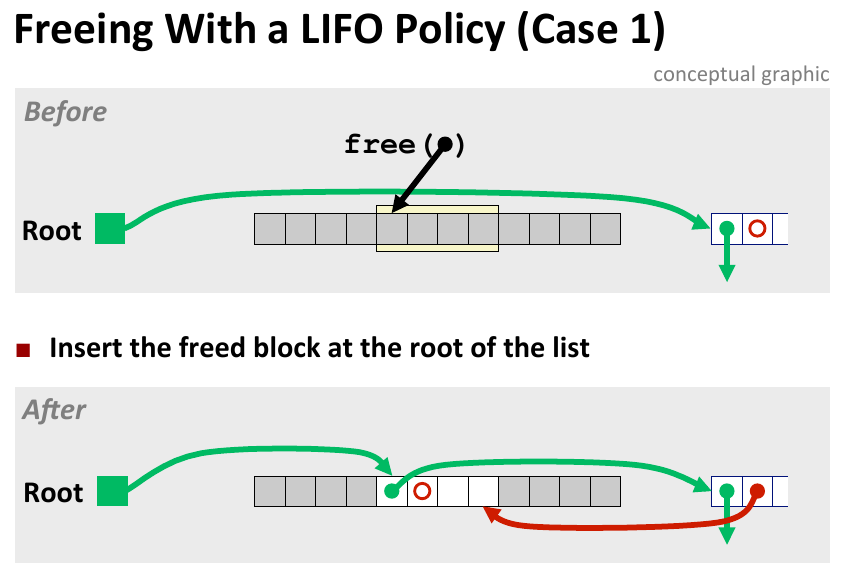
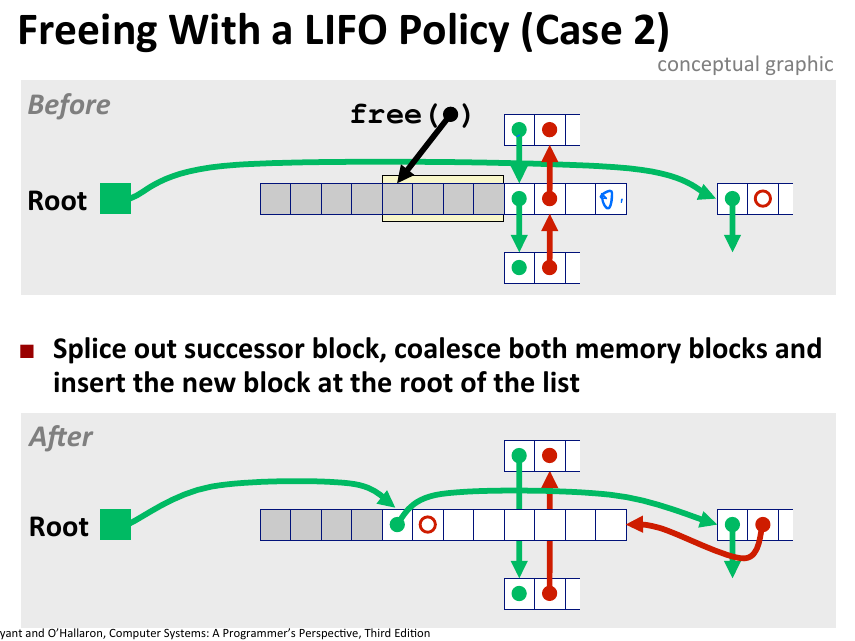
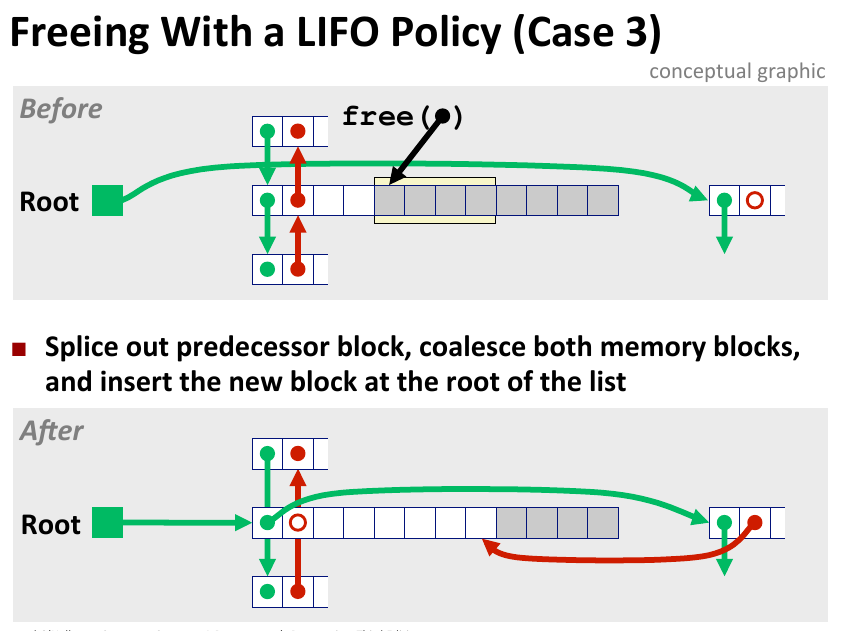
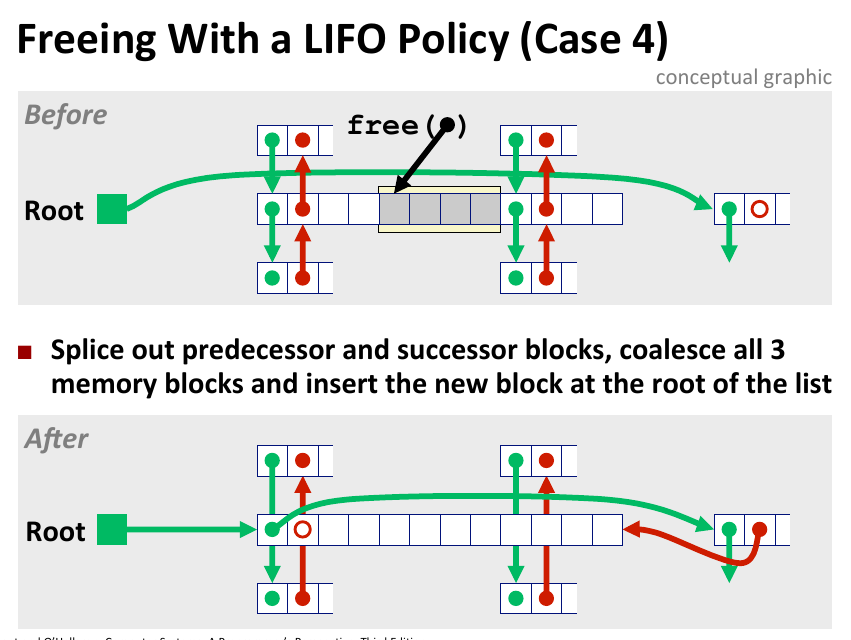
/**
* @brief Merge the address space and insert the available free block into the free list
*
* @param bp payload first address of the current block
*
*/
static void coalesce(void *bp)
{
char *prev_blockp = PREV_BLKP(bp);
char *next_blockp = NEXT_BLKP(bp);
char *mem_max_addr = (char *)mem_heap_hi() + 1; // Upper boundary of heap
size_t prev_alloc = GET_ALLOC(HDRP(prev_blockp));
size_t next_alloc;
if (next_blockp >= mem_max_addr)
{ // next_block exceeds the upper boundary of heap, and only prev is considered_ blockp
if (!prev_alloc)
{
case3(bp);
}
else
{
case1(bp);
}
}
else
{
next_alloc = GET_ALLOC(HDRP(next_blockp));
if (prev_alloc && next_alloc)
{ // case 1: both the front and back have been allocated
case1(bp);
}
else if (!prev_alloc && next_alloc)
{ //case 3: not allocated before, allocated after
case3(bp);
}
else if (prev_alloc && !next_alloc)
{ // case 2: pre allocated, post unassigned
case2(bp);
}
else
{ // case 4: not assigned before and after
case4(bp);
}
}
}
case1
/**
* @brief Both front and rear distribution
*
* @param bp
* @return void*
*/
static void *case1(void *bp)
{
insert_to_free_list(bp);
return bp;
}
case2
/**
* @brief Not allocated after pre allocation
*
* @param bp
* @return void*
*/
static void *case2(void *bp)
{
void *next_blockp = NEXT_BLKP(bp);
void *prev_free_blockp;
void *next_free_blockp;
size_t size = GET_SIZE(HDRP(bp)) + GET_SIZE(HDRP(next_blockp));
// Update block size
PUT(HDRP(bp), PACK(size, 0));
PUT(FTRP(next_blockp), PACK(size, 0));
// free block pointer before and after update
prev_free_blockp = PREV_FREE_BLKP(next_blockp);
next_free_blockp = NEXT_FREE_BLKP(next_blockp);
// Boundary check
if (next_free_blockp == NULL)
{
PUT(NEXT_PTR(prev_free_blockp), NULL);
}
else
{
PUT(NEXT_PTR(prev_free_blockp), next_free_blockp);
PUT(PREV_PTR(next_free_blockp), prev_free_blockp);
}
insert_to_free_list(bp);
return bp;
}
case3
/**
* @brief case 3 The previous block is not allocated, and the latter block is allocated
*
* @param bp The payload first address of the current block
* @return void* Merged payload first address
*/
static void *case3(void *bp)
{
char *prev_blockp = PREV_BLKP(bp);
char *prev_free_blockp;
char *next_free_blockp;
size_t size = GET_SIZE(HDRP(bp)) + GET_SIZE(HDRP(prev_blockp));
// Update block size
PUT(HDRP(prev_blockp), PACK(size, 0));
PUT(FTRP(prev_blockp), PACK(size, 0));
// Find the front and back free blocks and update them
next_free_blockp = NEXT_FREE_BLKP(prev_blockp);
prev_free_blockp = PREV_FREE_BLKP(prev_blockp);
// Boundary check
if (next_free_blockp == NULL)
{
PUT(NEXT_PTR(prev_free_blockp), NULL);
}
else
{
PUT(NEXT_PTR(prev_free_blockp), next_free_blockp);
PUT(PREV_PTR(next_free_blockp), prev_free_blockp);
}
// LIFO policy, inserted into the header of free list
insert_to_free_list(prev_blockp);
return bp;
}
case4
/**
* @brief Not assigned before and after
*
* @param bp
* @return void*
*/
static void *case4(void *bp)
{
void *prev_blockp;
void *prev1_free_blockp;
void *next1_free_blockp;
void *next_blockp;
void *prev2_free_blockp;
void *next2_free_blockp;
size_t size;
prev_blockp = PREV_BLKP(bp);
next_blockp = NEXT_BLKP(bp);
// Update size
size_t size1 = GET_SIZE(HDRP(prev_blockp));
size_t size2 = GET_SIZE(HDRP(bp));
size_t size3 = GET_SIZE(HDRP(next_blockp));
size = size1 + size2 + size3;
PUT(HDRP(prev_blockp), PACK(size, 0));
PUT(FTRP(next_blockp), PACK(size, 0));
bp = prev_blockp;
// Update the first half of the free block pointer
prev1_free_blockp = PREV_FREE_BLKP(prev_blockp);
next1_free_blockp = NEXT_FREE_BLKP(prev_blockp);
if (next1_free_blockp == NULL)
{
PUT(NEXT_PTR(prev1_free_blockp), NULL);
}
else
{
PUT(NEXT_PTR(prev1_free_blockp), next1_free_blockp);
PUT(PREV_PTR(next1_free_blockp), prev1_free_blockp);
}
// Update the free block pointer in the second half
prev2_free_blockp = PREV_FREE_BLKP(next_blockp);
next2_free_blockp = NEXT_FREE_BLKP(next_blockp);
if (next2_free_blockp == NULL)
{
PUT(NEXT_PTR(prev2_free_blockp), NULL);
}
else
{
PUT(NEXT_PTR(prev2_free_blockp), next2_free_blockp);
PUT(PREV_PTR(next2_free_blockp), prev2_free_blockp);
}
// Insert free list according to LIFO policy
insert_to_free_list(bp);
return bp;
}
Other debug functions
static void debug()
{
print_allocated_info();
print_free_blocks_info();
consistent_check();
}
/**
* @brief Print allocation
*/
static void print_allocated_info()
{
char *bp;
size_t idx = 0;
char *mem_max_addr = mem_heap_hi();
printf("=============start allocated info===========\n");
for (bp = NEXT_BLKP(free_list_head); bp < mem_max_addr && GET_SIZE(HDRP(bp)) > 0; bp = NEXT_BLKP(bp))
{
if (GET_ALLOC(HDRP(bp)) == 1)
{
++idx;
printf("block%d range %p %p size=%d, payload %p %p block size=%d\n", idx, HDRP(bp), FTRP(bp) + WSIZE, FTRP(bp) - HDRP(bp) + WSIZE, (char *)bp, FTRP(bp), FTRP(bp) - (char *)(bp));
}
}
printf("=============end allocated info===========\n\n");
}
static void consistent_check()
{
// Check that all block s in the free list are free
char *bp;
char *mem_max_heap = mem_heap_hi();
for (bp = NEXT_FREE_BLKP(free_list_head); bp != NULL; bp = NEXT_FREE_BLKP(bp))
{
if (GET_ALLOC(HDRP(bp)))
{
printf("%d free list Block already allocated in\n", __LINE__);
}
}
// Check that all free block s are in the free list
for (bp = NEXT_BLKP(free_list_head); bp <= mem_max_heap; bp = NEXT_BLKP(bp))
{
if (!GET_ALLOC(HDRP(bp)) && !is_in_free_list(bp))
{
printf("%d existence free block %p be not in free list in\n", __LINE__, bp);
}
}
}
static int is_in_free_list(void *bp)
{
void *p;
for (p = NEXT_FREE_BLKP(free_list_head); p != NULL; p = NEXT_FREE_BLKP(p))
{
if (p == bp)
{
return 1;
}
}
return 0;
}
The above is the implementation of the entire explicit list. The final effect is that after running all trace file s, the score is 83 / 100 It's a good level. To achieve excellence, consider making a aggregated list or a red block tree list
Let's talk about some optimization:
- Space optimization: for the allocated block, the NEXT and PREV pointers can not be stored, so as to expand the payload space and improve the space utilization
- Encapsulate the entire free list, and then use the aggregated list instead
- Now the search strategy is from the beginning to the end, which is relatively slow. You can establish an index for each free block, and select rbtree as the index data structure, which should greatly improve the allocation throughput
5. Summary
Well, personally, I think this lab is next to cachelab, but its difficulty is not thinking, but how to debug. After all, chicken like me, no debug is impossible. This life can not be debug, but this time lab has many macros, it is very difficult to debug in gdb, gdb can only view the continuous address memory space through exam command. However, when the malloc size given in the trace file is too large, the exam command is also difficult to view quickly. Therefore, when individuals are doing this, manually reduce the malloc size of the trace file (of course, it is changed back later), and then debug will be relatively easier
Original link
https://zhuanlan.zhihu.com/p/126341872
https://www.ravenxrz.ink/archives/36920455.html